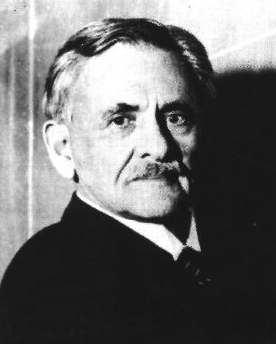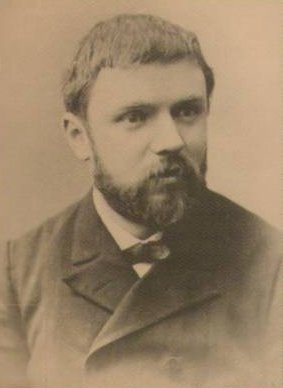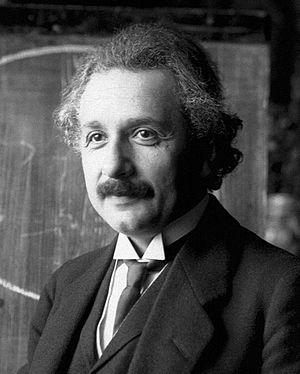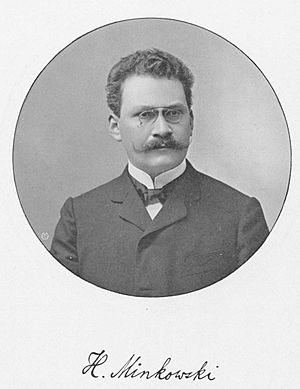History of special relativity facts for kids
The history of special relativity is a story of many smart scientists and their discoveries. People like Albert A. Michelson, Hendrik Lorentz, and Henri Poincaré made important steps. Their work led to the theory of special relativity by Albert Einstein. Later, Max Planck and Hermann Minkowski also added to this amazing theory.
Special relativity changed how we understand space and time. Before Einstein, people like Isaac Newton thought space and time were absolute. This meant they were the same for everyone, no matter how they were moving. But Galileo Galilei had an idea called the principle of relativity. It said that the laws of mechanics (how things move) are the same for all observers moving at a steady speed. No special "resting" state exists.
In the 1800s, scientists thought light traveled through an invisible substance called the "luminiferous aether". They believed this aether filled all space. James Clerk Maxwell developed equations showing light as waves in this aether. This suggested it should be possible to measure Earth's motion through the aether.
However, experiments failed to find this motion. This led Hendrik Lorentz to develop a theory in 1892. He imagined an unmoving aether and suggested that objects moving through it would shrink (length contraction). He also introduced "local time," which helped Maxwell's equations work in all moving frames.
Henri Poincaré then improved Lorentz's ideas in 1905. He used the "relativity principle" to make Lorentz's math exact. These equations are now called the Lorentz transformations.
Later that same year, Albert Einstein published his own paper on special relativity. He started with two main ideas: the relativity principle and the idea that the speed of light is always the same for everyone. From these, he figured out the Lorentz transformations. Einstein changed how we think about space and time. He said that "absolute simultaneity" (events happening at the exact same time for everyone) isn't real. He also didn't need the idea of an aether.
Later, Hermann Minkowski created a 4-dimensional "spacetime" model for Einstein's theory. This model combined space and time. It helped Einstein develop his general theory of relativity later on.
Contents
Early Ideas About Light and Aether
Aether Models and Light Waves
For a long time, scientists thought light traveled as waves through an invisible, springy substance called the luminiferous aether. This idea came from scientists like Thomas Young (1804) and Augustin-Jean Fresnel (1816).
Later, James Clerk Maxwell (1864) created a complete theory of electromagnetism. His Maxwell's equations showed that light was actually an electromagnetic wave. He believed these waves traveled through the same aether that caused electric and magnetic effects.
After Heinrich Hertz proved electromagnetic waves existed in 1887, Maxwell's theory became widely accepted. Scientists like Oliver Heaviside and Hertz made Maxwell's equations even better.
Searching for the Aether Wind
Scientists tried to find evidence of this aether. One idea, from Fresnel, was that the aether was mostly still. Objects moving through it would only drag it a little. This helped explain things like the bending of starlight (aberration). Another idea, from George Gabriel Stokes, was that the aether was completely dragged along by moving objects.
The Fizeau experiment in 1851 supported Fresnel's idea. It measured the speed of light in moving water. The results showed that the water dragged the light a little, but not completely.
Albert A. Michelson (1881) tried to measure Earth's motion through the aether using a device called an interferometer. He expected to see a "aether wind" as Earth moved. But he found no motion. At first, he thought this supported the idea that the aether was completely dragged.
However, Hendrik Lorentz (1886) showed Michelson's calculations might be wrong. So, Michelson and Edward W. Morley (1886) repeated the Fizeau experiment, confirming Fresnel's partial dragging idea.
To clear things up, Michelson and Morley (1887) did their famous Michelson–Morley experiment again. They made it much more accurate. Still, they found no sign of Earth moving through the aether. This was a big puzzle! It seemed to contradict the Fizeau experiment.
A scientist named Woldemar Voigt (1887) found some math that could explain the Michelson-Morley result. His equations included a factor that looked like the Lorentz factor and a "local time." But his work was mostly ignored.
FitzGerald (1889) and Hendrik Lorentz (1892) independently suggested a solution: objects moving through the aether would shrink in the direction of their motion. This idea is called length contraction. It was a way to explain why the Michelson-Morley experiment found nothing.
Electromagnetic Mass
Scientists also discovered that charged objects have an "electromagnetic mass." This means that the energy in their electric fields adds to their mass. J. J. Thomson (1881) was one of the first to notice this. Heaviside and George Frederick Charles Searle (1896) found that this electromagnetic mass changed with speed. They also realized that it would take infinite energy to reach the speed of light.
Wilhelm Wien (1900) suggested that all mass might be electromagnetic. Henri Poincaré (1900) also connected mass and energy. He said that electromagnetic energy acts like a fluid with a mass density of `m=E/c^2` (or `E=mc^2`).
Walter Kaufmann (1901–1903) did experiments with cathode rays. He showed that the mass of electrons increased as they moved faster. This supported the idea of electromagnetic mass.
Poincaré and Lorentz's Work
Lorentz's Electron Theory
Hendrik Lorentz (1892) developed his Lorentz aether theory. He imagined tiny particles called electrons moving through a completely still aether. In his theory, the speed of light was always the same, no matter how fast the light source was moving.
Lorentz also used "local time" in his equations. This was a mathematical trick to make his theory work. But Henri Poincaré (1900) later realized that "local time" was actually what moving clocks would show! Lorentz's theory also had a problem: the aether could act on matter, but matter couldn't act back on the aether.
Joseph Larmor (1897, 1900) developed a similar model. He was the first to write Lorentz's transformations in their modern form. He also found that length contraction and a kind of time dilation (clocks slowing down) could be derived from his model. Lorentz (1899) also found this time dilation effect.
Light Speed and Relativity Principle
In the late 1800s, people were trying to build a worldwide clock network. They realized that light signals, used for synchronization, travel at a finite speed.
Henri Poincaré (1898) wrote about how astronomers assumed light has a constant speed in all directions to measure it. He also said that we define "simultaneity" (what happens at the same time) in a way that makes natural laws as simple as possible.
Poincaré (1895, 1900) argued that experiments like Michelson-Morley showed it was impossible to detect absolute motion. He called this the "principle of relative motion." He also explained Lorentz's "local time" as the result of clocks synchronizing with light signals. He said that moving observers, unaware of their motion, would think their clocks were synchronized, but from a "resting" observer's view, they wouldn't be.
Lorentz's 1904 Model
In 1904, Lorentz tried to make his theory fully consistent with the relativity principle. He wanted to explain why all experiments failed to detect aether motion. He also suggested that all mass might be electromagnetic. He derived correct formulas for how mass changes with speed, which matched experiments by Kaufmann. Lorentz also proposed that his transformations should apply to non-electrical forces too.
Poincaré (1904) gave a lecture where he clearly stated the "Principle of Relativity." He said that the laws of physics must be the same for observers moving at a steady speed. This means we can never know if we are moving through an aether or not. He also talked about a "new mechanics" where nothing could go faster than light.
Poincaré's Electron Dynamics
On June 5, 1905, Henri Poincaré submitted a paper that fixed some issues in Lorentz's work. He showed that Lorentz's equations weren't fully "Lorentz-covariant" (meaning they didn't look the same in all moving frames). He corrected the formulas for things like charge density. Poincaré was the first to use the term "Lorentz transformation" and gave them their modern, symmetrical form.
He also added a non-electrical force (called "Poincaré stresses") to explain why electrons stay stable and why length contraction happens. He even thought about how gravity might work with these new ideas.
In a longer paper (published January 1906), Poincaré called the relativity idea a "postulate." He showed that the Lorentz transformations were a result of the principle of least action. He also showed that the combination `x^2+y^2+z^2-c^2t^2` stays the same for all observers. He even used `ct√-1` as a fourth, imaginary coordinate, showing that the Lorentz transformation was like a rotation in a four-dimensional space.
Even though Poincaré was very close, most historians agree that he didn't invent what we now call special relativity. He still believed in an undetectable aether and thought there was a "true" time for observers at rest in it.
Einstein's Special Relativity
Einstein's 1905 Paper
On September 26, 1905, Albert Einstein published his famous paper on special relativity. His theory didn't need an aether. Einstein based his theory on two main ideas:
- The principle of relativity: The laws of physics are the same for all observers moving at a constant speed.
- The principle of the constancy of light: The speed of light in a vacuum is the same for all observers, no matter how fast the light source or the observer is moving.
Before Einstein, scientists had to add many special ideas to Lorentz's theory to explain why the aether couldn't be detected. This was like assuming many things just to make the theory work. Einstein was the first to get rid of these extra ideas. He simply took the two principles above as true. From these two simple ideas, he could derive all the results that his predecessors had found after years of complex work.
Lorentz later said, "Einstein simply postulates what we have deduced." Einstein also thought that since light could act like particles (photons), the idea of an aether as a medium for waves didn't fit as well.
Einstein said his ideas were influenced by philosophers like David Hume and Ernst Mach. He also learned from the moving magnet and conductor problem and the negative results of aether experiments. He denied that the Michelson-Morley experiment was the most important influence, but he did study Poincaré's Science and Hypothesis closely.
Einstein explained that he got the idea of constant light speed from Lorentz's theory. But he realized that if this was true, and the relativity principle was also true, then an aether wasn't needed to describe electrodynamics for observers moving at constant speeds. He also said that Lorentz's "local time" wasn't just a mathematical trick, but was actually time itself, connected to how signals travel.
Einstein later explained the main difference between his theory and Lorentz's. He said his work showed that the Lorentz transformations were about the nature of space and time in general, not just about Maxwell's equations. He also realized that "Lorentz invariance" (meaning laws look the same after a Lorentz transformation) is a general rule for any physical theory.
Mass–Energy Equivalence
In his 1905 paper, Einstein used a formula for the kinetic energy of an electron. He then published another paper where he showed that if a body loses energy (like light or heat), its mass decreases by `E/c^2`. This led to the famous formula: `E = mc^2`.
This equation was very important because it showed that mass and energy are two forms of the same thing. A particle at rest has a certain amount of energy, called "rest energy," just because it has mass. Before Einstein, some scientists had found similar formulas, but they usually only applied to electromagnetic energy. Einstein was the first to say this applied to all forms of energy and to connect it to the relativity principle.
Spacetime and Beyond
Minkowski's Spacetime
Henri Poincaré had hinted at a four-dimensional way to describe the new physics. But it was Hermann Minkowski (1907) who fully developed this idea. He combined space and time into a single, four-dimensional "spacetime".
Minkowski used ideas from mathematicians who studied group theory and geometry. He created the Minkowski diagram to show spacetime. He also introduced terms like "world line" (the path of an object through spacetime), "proper time" (the time measured by a clock moving with an object), and "Lorentz invariance" (laws looking the same in spacetime). He also wrote Maxwell's equations in this four-dimensional way.
Minkowski saw Einstein's theory as a broader version of Lorentz's. He praised Einstein for fully understanding the relativity of time. At first, Einstein and his colleague Laub thought Minkowski's spacetime idea was too complicated. But Einstein later (1912) realized how important it was. He used it as the basis for his work on general relativity.
Minkowski's model showed that special relativity was a complete and consistent theory. It also provided a way to calculate the actual time shown by moving clocks.
Time Dilation and the Twin Paradox
Einstein (1907) suggested a way to measure the transverse Doppler effect, which is a direct result of time dilation (clocks slowing down). This effect was measured in 1938 by Herbert E. Ives and G. R. Stilwell (Ives–Stilwell experiment).
Scientists also used "light clocks" to explain time dilation. Imagine two clocks, A and B, moving relative to each other. For an observer next to clock A, clock A runs normally. But when that observer looks at clock B, they see the light inside it taking a longer, angled path. So, clock B appears to run slower. However, for an observer moving with clock B, clock A would appear to run slower. This is called the reciprocity of time dilation.
Paul Langevin (1911) described a situation that became known as the "twin paradox". He imagined one twin staying on Earth and another twin traveling in a fast spaceship. When the traveling twin returns, they would be younger than the twin who stayed on Earth. Langevin explained this by saying the traveling twin experienced acceleration (speeding up and slowing down), which broke the symmetry.
Max von Laue (1913) further explained the twin paradox using Minkowski's spacetime model. He showed that the traveling twin's path through spacetime is shorter, meaning less proper time passes for them.
Acceleration
Einstein (1908) also tried to include accelerated motion in his theory. He realized that for any moment of acceleration, you can imagine a frame where the object is temporarily at rest. This led him to the equivalence principle, which says that acceleration and gravity are related. This idea went beyond special relativity and led to general relativity.
Minkowski (1908) also looked at constant acceleration within his spacetime model. He found that the path of such an object in spacetime is a hyperbola. This was further developed by Max Born (1909) and Arnold Sommerfeld (1910).
Rigid Bodies and the Ehrenfest Paradox
Einstein (1907) thought about whether information could travel faster than light in rigid bodies. He concluded it couldn't, because that would violate causality (cause and effect).
Max Born (1909) tried to include the idea of rigid bodies in special relativity. But Paul Ehrenfest (1909) showed this led to the Ehrenfest paradox. This paradox asks what happens to a spinning disk: due to length contraction, its circumference should shrink, but its radius shouldn't. This was a puzzle. Scientists like Max von Laue (1911) realized that the classical idea of a "rigid body" doesn't quite work in special relativity.
Acceptance of Special Relativity
By about 1911, most theoretical physicists accepted special relativity. Its development by Poincaré and Minkowski into a spacetime theory helped a lot. In 1912, Wilhelm Wien suggested Lorentz and Einstein for the Nobel Prize in Physics for their work on relativity. However, the Nobel committee decided not to award the prize for special relativity at that time.
Some scientists, like Abraham and Lorentz, still believed in the existence of an aether. But Einstein later (1918–1920) said that one could talk about a "relativistic aether," but it couldn't be thought of as something you move through. Einstein started using the term "special theory of relativity" in 1915 to tell it apart from his new theory, general relativity.
Relativity and Other Physics Areas
Gravitation
The first attempt to combine relativity with gravity was by Henri Poincaré (1905). He tried to change Newton's law of gravity to fit the Lorentz transformations. He showed that in a relativistic theory, gravity doesn't have to travel faster than light for planetary orbits to be stable.
However, these early theories of gravity had problems. They implied that gravitational energy could be negative, which would violate the principle of energy conservation.
Gunnar Nordström (1912, 1913) created a model that worked better. Einstein and Adriaan Fokker (1914) showed that in Nordström's model, gravity could be described by the curvature of spacetime. But Nordström's theory still allowed for special "preferred frames" of reference.
Einstein (1911–1915) then developed his "tensor theory," which is general relativity. This theory satisfied both the equivalence principle and general covariance (meaning laws look the same in all frames, even accelerating ones). In general relativity, the constancy of light speed and Lorentz covariance are only true locally (in small areas). Einstein's theory was proven correct when it accurately predicted the orbit of Mercury and the bending of light near the Sun.
Quantum Field Theory
Special relativity also became very important for quantum mechanics. Scientists needed to combine these two big theories. This led to the development of quantum field theory. Paul Dirac created the Dirac equation for electrons, which even predicted the existence of antimatter.
Many other areas of physics have also been updated to include relativity, such as relativistic thermodynamics (heat and energy) and relativistic hydrodynamics (fluid motion).
Proof from Experiments
Many experiments have confirmed special relativity:
- The Fizeau experiment (1851) showed how light speed changes in moving water.
- The Michelson–Morley experiment (1887) showed no aether wind.
- The Kaufmann–Bucherer–Neumann experiments showed that electron mass increases with speed.
- The Trouton–Noble experiment showed that a charged capacitor doesn't twist when moving.
- The Ives–Stilwell experiment (1938) directly measured time dilation.
- Measuring the decay rates of fast-moving particles also showed time dilation.
All these experiments have been repeated many times with even greater accuracy. We need to use these relativistic effects when building things like particle accelerators, where particles move very fast.
In the 1960s, scientists like J. G. Fox did new experiments using gamma rays from fast-moving particles. These experiments confirmed that the speed of light is constant, even for light that has passed through matter.
Today, scientists continue to test special relativity, looking for any tiny violations of its rules. So far, no signs of such violations have been found, even at incredibly precise levels.
See also
 In Spanish: Historia de la relatividad especial para niños
In Spanish: Historia de la relatividad especial para niños
- Timeline of special relativity and the speed of light
- Einstein's thought experiments
- History of Lorentz transformations
- Tests of special relativity







